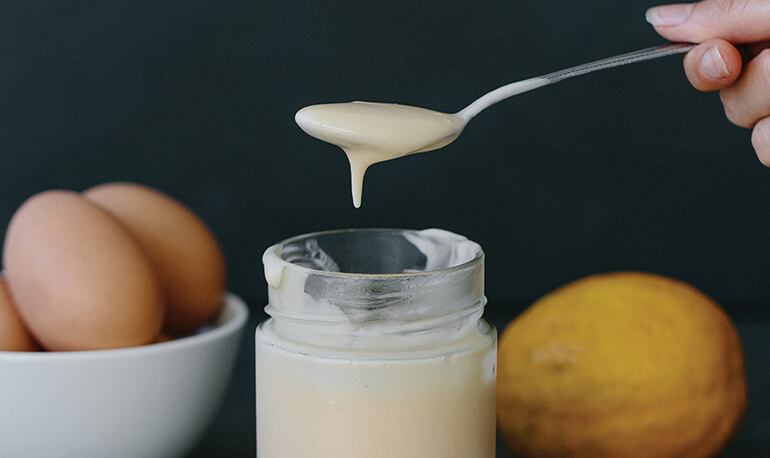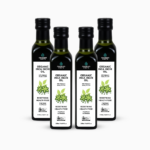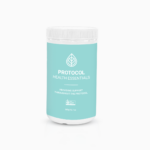In my last blog I talked about the ingredients commonly found in the store bought condiments that may be lurking in your pantry and which may impact your health.
I also talked about the food industry, specifically how these ingredients are made, their original sources and the genetic modification and changes to the micro-organisms and foods that may be employed in the process of producing a food additive.
I focused on tomato sauces and BBQ sauces, highlighting the ingredients of shop bought sauces and giving you easy-to-follow recipes for homemade healthier alternatives without the dubious ingredients.
In this blog, I want to dissect mayonnaise, hollandaise and sweet chilli sauce. Hold on to your hats, because when you learn some of the tricks the food manufacturers play you may just want to throw that container out of the window and into the rubbish!
Mayonnaise
Mayonnaise would have to be the easiest of all condiments to make and once you’ve made a basic recipe you can add all sorts of single ingredients to change it into wasabi mayo, aioli, herb mayo and so on.
Shop bought mayo ingredients can include vegetable oil (soybean), water, sugar, vinegar, egg yolk powder, salt, spices (mustard, black pepper, garlic onion), preservative 202, acidity regulator 270, stabiliser 415, antioxidant 385, beta-carotene (colour).
Let’s take a closer look at some of these ingredients:
- Soybean oil will be genetically modified if there is no indication on the label that it is non GM or organic and it will probably have Roundup (herbicide) residue. Moms Across America have been testing many foods and drinks and have found it hard to find foods without Roundup/glyphosate residue.
- Water is the second greatest ingredient – amazingly, it can only be used as a filler. This is a cheap ingredient and would increase food weight but not nutrition. If it’s from the tap it will have fluoride, chloride and anything that is in our water supply due to agricultural practices and pollution.
- Sugar – refined, white with not an ounce of nutrition; in fact sugar refiners are proud to announce that white sugar is 99.4% sucrose and .6% ash. When I asked them what the ash was they could not tell me.
- Vinegar – probably a grain-based distillation.
- Egg yolk powder – depending on where the powder is made it could have an anticaking agent in it (less than 2% sodium silicoaluminate). To make the egg powder the eggs are pasteurized and spray dried. There is also another process of spray drying eggs into a powder that includes the addition of gases which are fairly soluble in egg liquid, typically carbon dioxide or nitrous oxide. Other examples of gases which may be used are air, nitrogen, helium, propane, n-butane, isobutane, dichlorodifluoromethane, trichloromonofiuoromethane, trifluoromonochloromethane and the like; these gases must be non-toxic. The problem with buying egg yolk powder foods is that you really don’t know exactly what process they do, so it’s buyer beware. In reality it’s not the worst of ingredients, but I’d rather use my own organic free range eggs.
- Salt will be refined. Why not add some nutrition by adding our seaweed salt to your homemade recipe instead?
- Preservative 202 Potassium Sorbate – while it’s regarded as safe, some people will have an allergic reaction to it, or suffer from skin irritation or behavioural problems.
- Acidity regulator – I covered this in my last blog.
- Stabiliser 415 – I also covered xanthum gum in my last blog, but you can read more about it here.
- Preservative 385, otherwise known as calcium disodium ethylenediaminetetraacetate or calcium disodium EDTA for short. This preservative is banned in some countries. Potential effects includes muscle cramps, blood in urine, intestinal upset, kidney damage and chromosome damage. It also has the ability to increase uptake of heavy metals and may affect liver and reproduction. Hmm, doesn’t sound all that safe to me.
All food additives are tested alone to a safe threshold. Safety testing has never been done on combinations of food additives. In all my years of looking at food ingredients labels, it has been rare for me to find just one food additive in packaged food – commonly I find up to 50 additives in one product.
We are guinea pigs in a food race to make money for shareholders, rather than healthy foods that help the planet, our soils, animals and humans. Don’t be sucked into the convenience of these foods as that convenience will be shadowed by ill health.
Once again, in mayonnaise, you see similar additives to the BBQ and tomato sauce; the difference is that the mayo begins with oil instead of tomatoes, then in goes the same ingredients: acidity regulator, flavour, colour, xanthum gum, antioxidant and preservative. It’s all the same but the flavours differ to make you think you are eating something different.
My mayo recipe contains eggs, oil, vinegar and/or lemon juice, salt and pepper. You can make it in seconds with a stick blender and glass jar. You will never buy shop bought again!
Hollandaise Sauce
Let’s take a look at some common ingredients in shop bought hollandaise:
Packaged ingredient list 1: Modified corn starch, maltodextrin, wheat starch, whey protein concentrate, partially hydrogenated soybean oil, lactose, corn starch, hydrolyzed corn gluten, salt, fructose, citric acid, onion powder, autolyzed yeast extract, guar gum, spices, turmeric (colour), caramel colour, natural flavour, garlic powder dextrose.
Packaged ingredient list 2: Water, sunflower, oil, modified starch (1442, 1450), milk solids, salt, egg yolk, sugar, milk powder, lemon juice, white distilled vinegar powder, maltodextrin, white wine extract powder, vegetable fibre, herbs, spices, food acid, colour, yeast extract, tamarind extract, natural flavour, natural antioxidant.
Packaged ingredient list 3: Corn starch, maltodextrin, whey protein concentrate, hydrolyzed corn protein, wheat with fortification, including folic acid, sugar, butter, onion powder, citric acid, yeast extract, high oleic sunflower oil, guar gum, salt, annatto extract, paprika and turmeric for colour, garlic powder, soybean oil, sodium caseinate, spice, dehydrated lemon juice, natural flavour.
To each of these powders you add milk and margarine (packed with more additives and chemicals) and heat.
I have one comment – ‘chemical shit storm’!
Here are the ingredients for my hollandaise sauce recipe: eggs, ghee, lemon juice, seaweed salt and pepper. It’s made in less than 4 minutes, quicker than going down to the shops to buy the fake stuff.
My pantry is a one ingredient pantry – everything in it is mainly based on one ingredient (nuts, flours, spices, herbs, etc), then with those ingredients I can make thousands of recipes. Recipes do not have to be long winded and take you all day. With technology today, you no longer have to hand whisk mayo or hollandaise, but can instead opt to use a stick blender or a Thermomix (an apprentice in the kitchen).
Sweet Chilli Sauce
The last condiment I’d like to analyse is Sweet Chilli Sauce. Here are the ingredients commonly found in store bought versions:
Sauce 1: Sugar, pickled red chilli (21%), water, garlic, vinegar, salt, stabiliser 415 – xanthum gum.
Sauce 2: Sugar syrup, tomato puree (water, tomato paste), vinegar, vegetables (fresh & rehydrated), water, rehydrated chilli (3.6%), maltodextrin, salt, thickener (1422), vegetable gum (415).
Sauce 3: Water, sugar, golden syrup, salt thickeners (modified corn starch), xanthum gum, food acid (acetic), garlic, paprika, honey, ginger, chilli (.5%).
Once again, this follows a similar theme as all the other foods we’ve talked about with ingredients like gums, thickeners, stabilisers, acidity regulator and preservative. There are no flavours in the chilli sauce but I find it interesting that the ingredient ‘chilli’ ranges in amounts from 21% to 0.5%.
Here’s my simple recipe for Sweet Chilli Sauce.
Some Simple Changes You Can Make to Boost Your Health
Over these past two blogs, we’ve dissected the ingredients of condiments that are often found in people’s pantries and fridges. Now that you have the knowledge, it may be a perfect time to read the ingredients of all your condiments and decide whether you are willing to continue to eat the additives that these packaged foods are made from.
As well as recipes for tomato sauce, BBQ sauce, mayonnaise, hollandaise and sweet chilli sauce found in these blogs, we also have recipes for other condiments like pestos and salad dressings available in our recipe book and online.
The quality of the ingredients are important; using white sugar, white salt and white vinegar may make the food taste good, but what we want is nutritional density. So instead, pantry swap those three ingredients for Rapadura sugar, seaweed salt and apple cider vinegar. All of these have nutrients far beyond their refined counterparts.
Go one step further and make sure your spices are organic and not irradiated and that your herbs come from your local farmers market or your garden as opposed to a market garden that uses chemical sprays for weeds, insects and fertilisation. As a side note, many of our store bought green leafy foods are being dipped in a sanitiser, so you are losing the soil microbes that help you digest your greens.
The oil for your mayonnaise should also be quality oil and not refined. We use Inca Inchi because of its taste and its nutritional value (it has 48% omega 3 and 84% essential fatty acids). You can also use olive, almond, avocado or macadamia oils, but make sure they are cold pressed and no chemicals have been sprayed on or around the crop.
All other vegetables can be purchased at your local farmers market. Make sure they are either certified organic or you fully trust the farmer you are buying from. You could even go out and visit them. If your farmer is fully transparent he/she will welcome your visit.
If you are in control of your food ingredients, you will gain more control over your health and that of your family. Teaching your children about food and getting them to help in the kitchen creates a wonderful foundation for our future generations.









Hi. So you cannot put these sauces into sterilised jars to keep as we only have short growing season for tomatoes and chillies
Also where can we look at videos on studio 10
Thanks
Helen
Hi Helen,
Because these sauces do not contain any artificial preservatives, they don’t keep as long as most store bought versions. However, they last pretty well in the fridge. Alternatively, you could try freezing the tomatoes, making sure to defrost and drain them before making the sauce.
You can watch the video from Studio 10 here: https://www.facebook.com/changinghabits/videos/551933608634374/
I hope this helps 🙂
Thanks Cyndi. Now going to make my own.